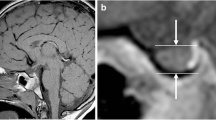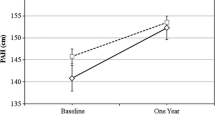Abstract
Prader-Willi syndrome (PWS) is an unusual genetic disorder characterized by short stature, obesity, hypogonadism, hypotonia, cognitive impairment, and dysmorphic facies. There is an interstitial deletion of the proximal long arm of chromosome 15 in about 70% of patients. Some of these clinical features suggest a central hypothalamic/pituitary dysfunction, and recent investigations have demonstrated a marked impairment in spontaneous growth hormone (GH) secretion. We studied 15 GH-deficient PWS patients by magnetic resonance imaging (MRI) to determine whether there was a diminution in the gross morphological size of the anterior pituitary gland, the site of GH synthesis. We also set out to catalog the pertinent imaging findings in this patient population. Our results indicate that this is the first report documenting pituitary size by MRI in PWS patients. No statistically significant difference was found in the height of the anterior pituitary gland in PWS patients compared with either normal children or children with isolated GH deficiency. An interesting imaging finding is that three of 15 patients (20%) demonstrated complete absence of the posterior pituitary bright spot (PPBS), and a fourth patient demonstrated a small PPBS. These observations reflect an objective physiologic disturbance in the hypothalamus. The clinical and radiologic implications of these findings are discussed.
Similar content being viewed by others
References
Zellweger H, Soper R (1979) The Prader-Willi syndrome. Med Hyg 37:3338–3345
Holm VA, Cassidy SB, Butler MG, et al (1993) Prader-Willi syndrome: consensus diagnostic criteria. Pediatrics 91: 398–402
Cassidy SB (1984) Prader-Willi syndrome. Curr Prob Pediatr 14: 1–55
Angulo M, Castro-Magana M, Uy J (1991) Pituitary evaluation and growth hormone treatment in Prader-Willi syndrome. J Pediatr Endocrinol 4: 167–173
Tien R, Kucharczyk J, Kucharczyk W (1991) MR imaging of the brain in patients with diabetes insipidus. AJNR 12: 533–542
Fujisawa I, Nishimura K, Asato R, et al (1987) Posterior lobe of the pituitary in diabetes insipidus: MR findings. J Comput Assist Tomogr 11: 221–225
Agyropoulou M, Perignon F, Brunelle F, et al (1991) Height of normal pituitary gland as a function of age evaluated by magnetic resonance imaging in children. Pediatr Radiol 21: 247–249
Suzuki M, Takashima T, Kadoya M, et al (1990) Height of normal pituitary gland on MR imaging: age and sex differentiation. J Comput Assist Tomogr 14:36–39
Doraiswamy PM, Potts JM, Axelson DA, et al (1992) MR assessment of pituitary gland morphology in healthy volunteers: age- and gender-related differences. AJNR 13: 1295–1299
Costeff H, Holm VA, Ruvalcaba R, et al (1990) Growth hormone secretion in Prader-Willi syndrome. Acta Pediatr Scand 79:1059–1062
Elster AD (1993) Modern imaging of the pituitary. Radiology 187: 1–14
Cacciari E, Zucchini S, Carla G, et al (1990) Endocrine function and morphological findings in patients with disorders of the hypothalamo-pituitary area: a study with magnetic resonance. Arch Dis Child 65:1199–1202
Fujisawa I, Asato R, Kawata M, et al (1989) Hyperintense signal of the posterior pituitary on Tl-weighted MR images: an experimental study. J Comput Assist Tomogr 13: 371–377
Kucharczyk J, Kucharczyk W, Berry I, et al (1988) Histochemical characterization and functional significance of the hyperintense signal on MR images of the posterior pituitary. AJNR 9: 1079–1083
Gudinchet F, Brunelle F, Barth MO, et al (1989) MR imaging of the posterior hypophysis in children. AJNR 10: 511–514
Ledbetter DH, Riccardi VM, Airhart SD, et al (1981) Deletions of chromosome 15 as a cause of the Prader-Willi syndrome. N Engl J Med 304: 325–329
Mascari MJ, Gottlieb M, Rogan PK, et al (1992) The frequency of uniparental disomy in Prader-Willi syndrome. N Engl J Med 326: 1599–1607
Ruvalcaba RH, Holm VA (1993) Effects of growth hormone in Prader-Willi syndrome. Clin Pediatr 32: 292–295
Author information
Authors and Affiliations
Rights and permissions
About this article
Cite this article
Miller, L., Angulo, M., Price, D. et al. MR of the pituitary in patients with Prader-Willi syndrome: Size determination and imaging findings. Pediatr Radiol 26, 43–47 (1996). https://doi.org/10.1007/BF01403704
Received:
Accepted:
Issue Date:
DOI: https://doi.org/10.1007/BF01403704




